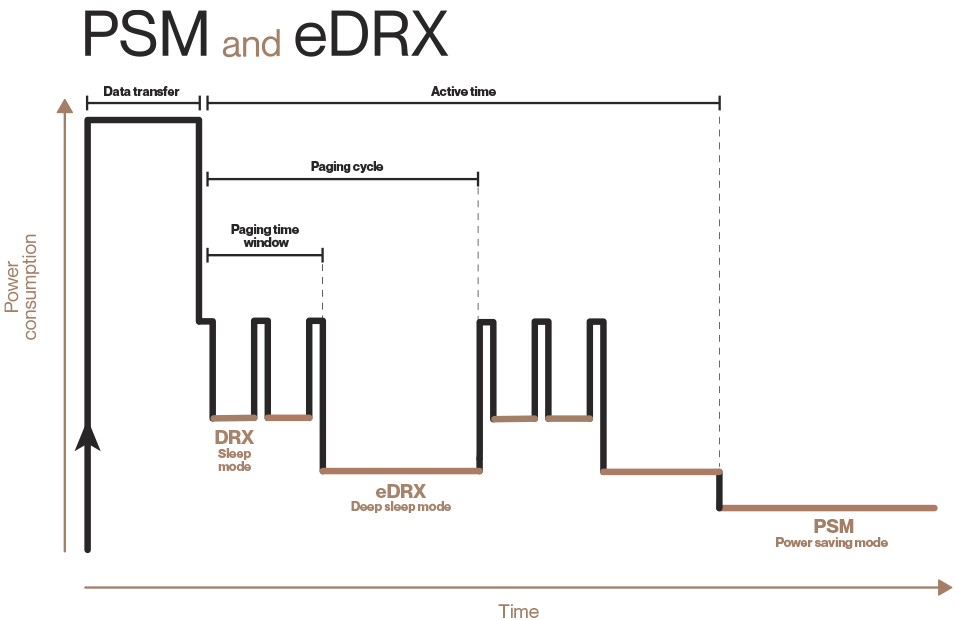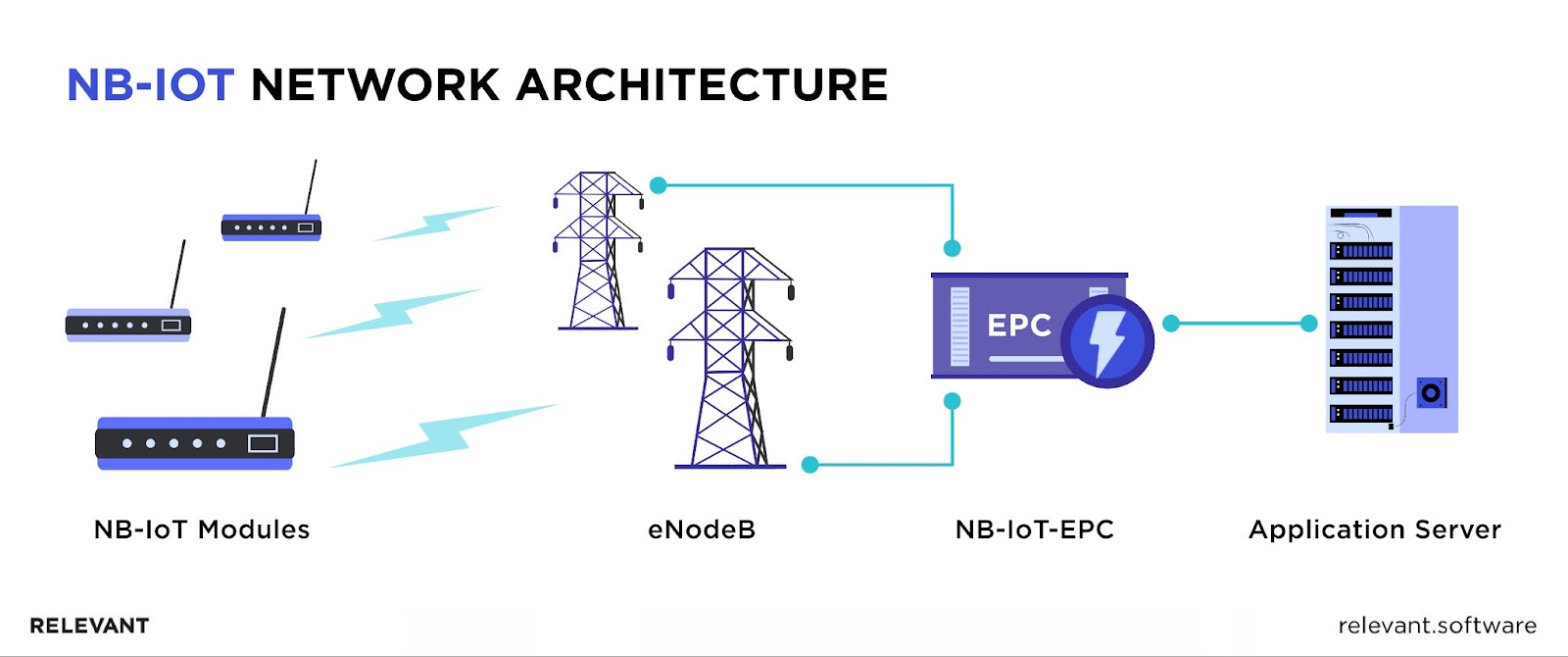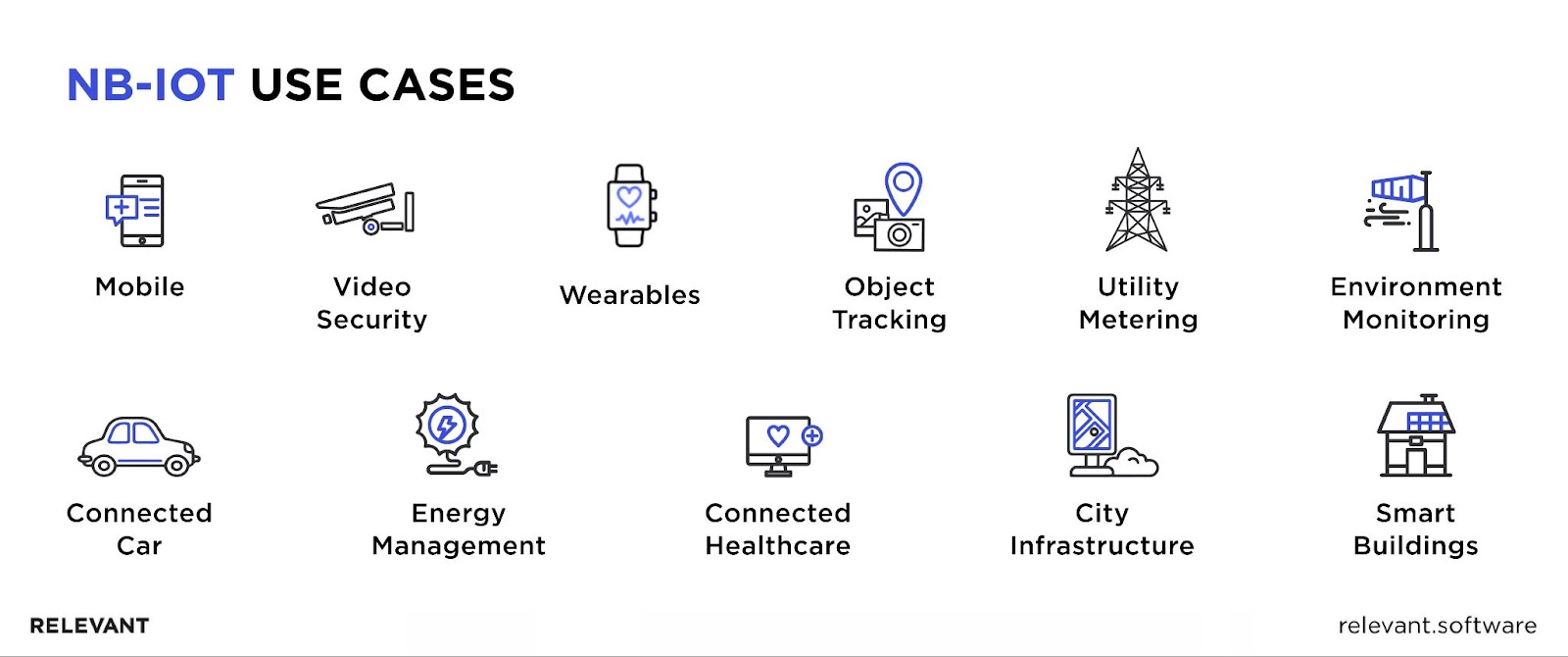NB-IoT, and its Role in the Internet of Things (IoT) Ecosystem

NB-IoT, or Narrowband IoT, is a wireless connectivity standard for the Internet of Things and is part of the low-power wide-area networks (LPWAN) category. But what makes it so extraordinary that we dedicated a whole article to it? Right, catch the details. Devices connected via NB-IoT can maintain a battery life exceeding ten years. Overwhelming, isn’t it? Additionally, NB-IoT can connect large fleets, accommodating up to 50,000 devices per network cell. That is a lot, definitely.
It achieves this while maintaining low power consumption and extending coverage into areas typically beyond the reach of conventional cellular technologies. This efficiency and capability explain why over 80 NB-IoT networks have been commercially deployed in more than 45 markets. If you are curious about what is NB IoT, how it works, and which systems it applies to, our IoT development company, with many years of experience, can help you get the drift.
Understanding the Basics of Narrowband IoT Technology
The 3rd Generation Partnership Project (3GPP) developed the NB-IoT wireless connectivity standard to facilitate cellular wireless communication for a broad array of IoT devices and services. As one of the primary 3GPP LPWAN standards, NB IoT enables specially designed IoT devices to function via carrier networks.
This is achieved through several methods: by utilizing the existing Global System for Mobile (GSM) communication carrier wave, occupying an idle guard band amidst Long-Term Evolution (LTE) channels, or operating independently. The main goal of NB-IoT is to expand coverage significantly beyond the limits of current cellular technologies.
How NB-IoT Works: Brief Explanation
Let’s start by answering the question – what is NB-IoT? It is a low-power wide-area (LPWA) technology standardized and integrated into mobile networks. It uses a cellular spectrum in the lower MHz range with a bandwidth of 200kHz, offering a broader channel range compared to LTE or Wi-Fi.
Its connection begins when the device modem reaches out to the base station, establishing a link. If the communication channel is busy, the modem employs EDRX and PSM, the primary techniques for reducing power consumption. The modem also enters a dormant state during periods awaiting new data transmission.

Source: Onomondo
Although NB IoT’s network speed is limited to 250 kbit per second, it ensures steady data transmission, a critical benefit for IoT device manufacturers. Unlike traditional LTE bands, NB-IoT operates independently of a gateway, lowering entry barriers for certain businesses and telecom operators. Its support for low data rates is a defining feature, marking it an efficient choice in the LPWAN landscape for minimal and optimized data transfer.
Its design to support only low data rates is a strategic advantage, positioning it as an efficient LPWAN choice for minimizing and managing data transfer. Because it can penetrate well indoors and is optimized for low data rates, NB-IoT is the best for devices such as smart meters, sensors, and trackers that send data sporadically.
These devices can transmit data to a central cloud or have it processed at mobile operator base stations with mobile ad hoc cloud technology, a forward-thinking edge computing approach.
| Feature | NB-IoT Technical Specification | Recommended Values |
| Data Volume | Air interface resources are limited (180 kHz), ideal for transmitting small amounts of data | The optimal range is 50 to 200 bytes; less is more favorable |
| Transmission Frequency and Duration | Devices mostly in hibernation, infrequent data transmission | Daily reports, ideally 1-2 times; more frequent reports (e.g., every 30 minutes) use more network capacity and impact it more |
| Power Efficiency | NB network’s Power Saving Mode (PSM) minimizes energy use | Best suited for power-sensitive applications |
| Mobility Support | Designed for low-speed movement | Suitable for speeds under 30 km/h |
| Signal Penetration | Effective in deep coverage areas | It can coexist with other networks, so it works well in dense areas like cities, offices, and neighborhoods. |
| Data Transfer Rate | Maximum theoretical upstream rate: 15.6 Kbit/s; downstream rate: 21.25 Kbit/s | Not suitable for high-bandwidth services |
The potential of NB-IoT presents significant business opportunities for stakeholders, who can select from three main approaches based on their regional strategies:
- Connectivity: Beyond just providing reliable IoT connectivity, operators can explore various use cases like smart metering for electricity and water, home alarms, vehicle tracking, connected street lamps, health monitoring devices, and more to increase revenue.
- NB-IoT Network as a Service: Offering carrier-grade solutions that include security, billing, big data integration, and Quality of Service (QoS) allows for the creation and enhancement of businesses. This approach aligns with global trends in network virtualization and cloud-based services.
- End-to-End Service Provision: Operators can also consider becoming end-to-end service providers for specific IoT solutions. This requires careful planning, technology, and business partnerships within the industry, and may involve outsourcing and revenue-sharing models.

NB-IoT vs. Other IoT Connectivity Options
What is NB-IoT difference compared with other prominent connectivity technologies? Let’s look.
NB-IoT vs. LoRaWAN
- Bandwidth and Range: NB IoT uses a licensed spectrum with a narrow bandwidth, offering efficient power usage and deep indoor penetration. LoRaWAN operates in the unlicensed spectrum and provides extended coverage at the cost of higher power consumption.
- Network Infrastructure: NB IoT leverages existing cellular infrastructure, whereas LoRaWAN requires the setup of dedicated gateways.
- Data Throughput: LoRaWAN typically supports higher data rates compared to NB-IoT.
NB-IoT vs. Sigfox
- Coverage: Sigfox offers broad coverage with a low-power, low-data-rate approach, similar to NB-IoT. However, Sigfox operates in the unlicensed spectrum.
- Network Model: Sigfox uses a more centralized network model, with each device communicating directly to the Sigfox cloud, unlike the cellular model of NB-IoT.
- Global Reach: Sigfox has a more uniform global presence, while NB-IoT deployment can vary depending on regional cellular network infrastructure.
NB-IoT vs LTE-M
- Latency and Bandwidth: LTE-M supports higher bandwidth and lower latency than NB-IoT, making it suitable for more data-intensive and real-time applications.
- LTE M vs NB IoT Mobility: LTE-M is suitable for static and mobile devices, while NB-IoT is only suitable for fixed (stationary) assets and devices.
- Battery Life: NB-IoT generally offers longer battery life due to its simpler modulation and narrower bandwidth.
- LTE-M vs NB-IoT global deployment and roaming: NB-IoT operates on both 2G and 4G networks, unlike LTE-M, which is limited to 4G. While LTE-M seamlessly integrates with existing LTE networks, NB-IoT uses DSSS modulation and needs specific hardware. Both technologies will be compatible with 5G networks.
| LoRaWAN | Sigfox | NB-IoT | LTE Cat-M1 | |
| Coverage (MCL) | 157dB | 162 dB | 164dB | 155dB |
| Technology | Proprietary | Proprietary | Open LTE | Open LTE |
| Spectrum | Unlicensed | Unlicensed | Licensed (LTE/any) | Licensed (LTE/any) |
| Duty cycle limit | Yes | Yes | No | No |
| Output power restrictions | Yes (14 dBm=25 mW) | Yes (14 dBm=25 mW) | No (23dBm = 200 mW) | No (23dBm = 200 mW) |
| Downlink data rate | 0.3-50 kbps | <1 kbps | 0.5-27.2 kbps | <300 kbps |
| Uplink data rate | 0.3-50 kbps | <1 kbps | 0.3-32.25 kbps | <375 kbps |
| Battery life/Current consumption | 8+ years/<2uA | 10+ years/<2uA | 10+ years/<3uA | 10+ years/<8uA |
| Module cost | <$10 | <$10 | <$10 | <$25 |
| Security | Medium (AES-128) | Low (AES-128) | Very high (LTE Security) | Very high (LTE Security) |
Source: Researchgate
Setting Up Your NB-IoT Development Environment
Setting up an NB-IoT development environment is a hands-on process and should, of course, be done by professionals. However, knowing its basic steps will not hurt all interested parties.
Essential Tools and Hardware
To describe these processes, we rely on our IoT developers’ experience and knowledge acquired in previous projects.
Choosing an NB-IoT module
Key considerations include the compatibility of connectivity bands in your region, the power consumption profile of the module, how well it integrates with your existing development boards, and the support and libraries available for your chosen module. We recommend options like the Arduino MKR NB 1500 for those just starting out, ST Nucleo NB-IoT boards for projects requiring more advanced features, or the U-blox SARA-R410M for its adaptability in custom designs.
Selecting the development kits and software
Your development kit should comprise a development board compatible with your module and any sensors and actuators your specific project might require. Also, a SIM card capable of supporting NB-IoT is essential, along with selecting an Integrated Development Environment (IDE) that suits your team’s expertise and project requirements.
Your next read – IoT Architecture Introduction
Configuring Your Development Environment
This stage involves tailoring your software and hardware setup to create an efficient, reliable workspace for coding, testing, and deploying your solutions.
Installation and setup guides
We typically begin by meticulously following the setup guidelines provided by the development board manufacturer. This ensures that the board is correctly configured to work with the NB-IoT module and the IDE. We ensure that the SIM card used is not only compatible with NB-IoT but also activated for use. Installing the necessary NB-IoT libraries specific to the chosen module and the IDE is a critical step, as these libraries often simplify many complexities inherent in IoT development.
First steps in programming an NB-IoT Module
When programming the Narrowband IoT module, we start with foundational tasks like data transmission, sensor data acquisition, and actuator control. We utilize the available libraries and sample codes provided by the module manufacturers, as these resources significantly reduce the learning curve and expedite the development process. Our team strongly emphasizes rigorous testing and iterative debugging, which are key to refining and ensuring the reliability of our NB-IoT solutions.
Developing Your First NB-IoT Project
The first step in developing a narrowband IoT project involves understanding its potential applications and identifying specific NB IoT use cases where it can be most effective. This process includes:
Identifying Use Cases and Applications
Narrowband IoT is highly versatile, excelling in various applications like remote monitoring, smart metering, and asset tracking. It’s ideal for scenarios requiring low power consumption (e.g., remote sensors), deep indoor penetration (such as underground settings), and low data rates (for basic telemetry). It offers long-range coverage and cost-effectiveness through cellular networks and infrastructure.

Sketching a Basic Project Design
Once we identify the use cases for your IoT project, we begin conceptualizing a basic design, which involves:
- Defining functionalities: Outlining your device’s capabilities, data handling, and environmental interactions.
- Choosing hardware: Selecting suitable NB-IoT modules, development boards, sensors, actuators, and other necessary components.
- Considering power needs: Ensuring the device’s operation within NB-IoT’s power parameters for the planned deployment duration.
- Planning data management: Determining approaches for data storage, processing, and visualization, often cloud platforms or on-premise servers.
Your next read – How to Build an IoT Dashboard
Programming and Connectivity
After laying down the foundation and design of your NB-IoT project, the next steps focus on the technical aspects.
Coding Basics for Narrowband IoT
We begin with the fundamentals of programming your NB IoT module. This includes the syntax and commands specific to your chosen platform, as well as how to read data from sensors and send commands to actuators.
Establishing Connectivity with NB-IoT Networks
A critical part of your project is establishing a reliable connection to Narrowband IoT networks. So, we configure your module to communicate with the network, fine-tune the network protocols, and ensure consistent and secure data transmission.
Advanced NB-IoT Development Concepts
Advanced development goes beyond basic implementations, focusing on optimizing performance, enhancing security, and ensuring scalability. As a rule, this is a custom solution tailored to the requirements of a specific project.
NB-IoT Protocols and Standards
While this might seem like information overload, protocols are essential in IoT implementations. Understanding CoAP, MQTT, and LWM2M within the context of NB-IoT is crucial for tailoring these protocols to meet your use case’s specific requirements effectively.
- CoAP (Constrained Application Protocol): Lightweight and resource-efficient for sending small data packets in NB-IoT applications.
- MQTT (Message Queuing Telemetry Transport): Reliable publish-subscribe protocol for transmitting sensor data to cloud platforms.
- LWM2M (Lightweight M2M): Device management protocol optimized for NB-IoT, enabling remote configuration and monitoring.
Power Management and Optimization
Effective power management is key in NB-IoT projects, particularly for devices deployed in remote or inaccessible locations.
Techniques for Extending Battery Life
There are various techniques and practices designed to enhance the energy efficiency of your NB-IoT devices, ensuring prolonged operational periods. These comprise:
- Minimizing data transmission frequency, optimizing sleep modes, and utilizing power-efficient libraries.
- Adapting power consumption based on device activity and environmental conditions.
- Implementing solar, piezoelectric, or other energy harvesting solutions for extended operation in remote locations.
Dealing with Connectivity Challenges
Here is the need to focus on identifying and overcoming common connectivity obstacles to maintain stable and efficient communication between your devices and the network. In this context, it is suggested to:
- Plan deployments in areas with adequate NB-IoT coverage, potentially utilizing signal boosters or antennas for improved connectivity.
- Understand the inherent latency limitations of NB-IoT and design applications that can function effectively with slightly slower data transfer.
- Implement robust security protocols and data encryption to protect your device and data from unauthorized access.
Testing and Deploying NB-IoT Solutions
These phases are crucial in ensuring the robustness and effectiveness of your NB-IoT solution, guaranteeing optimal performance in the varied and unpredictable real-world scenarios it may face.
Simulation and Testing Strategies
NB-IoT deployment begins with a well-structured simulation and IoT testing strategy.
Emulating Real-world Conditions
We utilize tools like hardware and software simulators to replicate the behavior of NB-IoT networks and test your device’s functionality in simulated environments. Following this, we transit to live network testing, starting with controlled environments and gradually expanding to full-scale deployments.
Testing for Reliability and Scalability
This phase is all about identifying any potential issues before the solution is live. The strategy encompasses a range of tests, from hardware functionality and software stability to network reliability and security protocols, including:
- Stress testing: We evaluate device performance under heavy data loads and network congestion to ensure stability and scalability.
- Security vulnerability testing: We identify and address potential security weaknesses to protect your device and data from cyber threats.
Deployment and Monitoring
When you’re ready to roll out your NB-IoT solutions into the real world, a couple of critical factors need to be meticulously handled.
Secure Network Access
Here, we adhere strictly to the guidelines provided by your network provider for device authentication and data encryption. It’s about ensuring that every bit of data transmitted is secure and that each device is authenticated correctly to prevent unauthorized access.
Physical Installation and Maintenance
You need to find spots where the signal strength is optimal. Also, think about the future – ensure that the devices are accessible for any maintenance or repairs. This foresight can save time and resources later on.
Remote Data Monitoring
You need to stay proactive by continuously monitoring device performance, data integrity, and battery levels. This approach helps prevent downtimes and maintains network health.
Over-the-Air Updates
We recommend utilizing NB-IoT’s remote update capabilities to manage firmware and configuration settings efficiently. This method offers convenience and enhances network security and efficiency, minimizing the need for physical device interactions
Final Words
NB-IoT’s evolution is transforming wireless network capacity, extending from static to mobile sensors with latency considerations. This technology appears highly promising for the smart future of our world.
For businesses looking to leverage NB-IoT’s benefits through development, consulting experts like those at Relevant is a strategic move. With extensive IoT project experience across various industries, our developers are well-equipped to develop future-ready, client-focused IoT applications. Contact us to discover how we can assist you in your NB IoT project.



